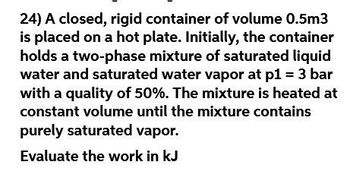
Elements Of Electromagnetics
7th Edition
ISBN: 9780190698614
Author: Sadiku, Matthew N. O.
Publisher: Oxford University Press
expand_more
expand_more
format_list_bulleted
Concept explainers
Question

Transcribed Image Text:24) A closed, rigid container of volume 0.5m3
is placed on a hot plate. Initially, the container
holds a two-phase mixture of saturated liquid
water and saturated water vapor at p1 = 3 bar
with a quality of 50%. The mixture is heated at
constant volume until the mixture contains
purely saturated vapor.
Evaluate the work in kJ
Expert Solution
This question has been solved!
Explore an expertly crafted, step-by-step solution for a thorough understanding of key concepts.
Step by stepSolved in 2 steps with 2 images

Knowledge Booster
Learn more about
Need a deep-dive on the concept behind this application? Look no further. Learn more about this topic, mechanical-engineering and related others by exploring similar questions and additional content below.Similar questions
- A rigid, closed container with a volume of 0.5 m3 is heated with an electric hot plate. The vessel initially contains water as a biphasic mixture of saturated liquid and saturated vapor at 100 kPa and quality 0.5. after heating the pressure rises to 150kpa.a) Draw the initial and final states on the T-v diagram.b) Determine the temperature for each state.c) determine the mass of vapor present in each state. FOLLOW THE NEXT STEPS Step 1. Sketch/Paraphrase (Draw the sketch and process diagram if necessary) 2. Theoretical Concepts / Formulas (write down the concepts you are applying and theformulation that will help you solve the problem 3. Information (tables, data in the program, graphs) Assumptions (In the event that they arenecessary) 4.Development Solution (Pay special attention to the units shown and requested)arrow_forwardA rigid, well-insulated tank contains a two-phase mixture of ammonia with 0.0022 ft³ of saturated liquid and 1.5 ft3 of saturated vapor, initially at p₁ = 70 lb/in². A paddle wheel stirs the mixture until only saturated vapor at higher pressure, p2, remains in the tank. Kinetic and potential energy effects are negligible. Determine the pressure p2, in lb/in², and the amount of energy transfer by work, in Btu. Step 1 * Your answer is incorrect. Determine p2, in lb/in². P2= i81.56 lb/in²arrow_forwardDetermine the quality, in percent, of a liquid-vapor mixture at 3 bars and a specific volume of 0.4 m³/kg. 66.0 а. с. 77.0 b. 71.0 d. 83.0arrow_forward
arrow_back_ios
arrow_forward_ios
Recommended textbooks for you
 Elements Of ElectromagneticsMechanical EngineeringISBN:9780190698614Author:Sadiku, Matthew N. O.Publisher:Oxford University Press
Elements Of ElectromagneticsMechanical EngineeringISBN:9780190698614Author:Sadiku, Matthew N. O.Publisher:Oxford University Press Mechanics of Materials (10th Edition)Mechanical EngineeringISBN:9780134319650Author:Russell C. HibbelerPublisher:PEARSON
Mechanics of Materials (10th Edition)Mechanical EngineeringISBN:9780134319650Author:Russell C. HibbelerPublisher:PEARSON Thermodynamics: An Engineering ApproachMechanical EngineeringISBN:9781259822674Author:Yunus A. Cengel Dr., Michael A. BolesPublisher:McGraw-Hill Education
Thermodynamics: An Engineering ApproachMechanical EngineeringISBN:9781259822674Author:Yunus A. Cengel Dr., Michael A. BolesPublisher:McGraw-Hill Education Control Systems EngineeringMechanical EngineeringISBN:9781118170519Author:Norman S. NisePublisher:WILEY
Control Systems EngineeringMechanical EngineeringISBN:9781118170519Author:Norman S. NisePublisher:WILEY Mechanics of Materials (MindTap Course List)Mechanical EngineeringISBN:9781337093347Author:Barry J. Goodno, James M. GerePublisher:Cengage Learning
Mechanics of Materials (MindTap Course List)Mechanical EngineeringISBN:9781337093347Author:Barry J. Goodno, James M. GerePublisher:Cengage Learning Engineering Mechanics: StaticsMechanical EngineeringISBN:9781118807330Author:James L. Meriam, L. G. Kraige, J. N. BoltonPublisher:WILEY
Engineering Mechanics: StaticsMechanical EngineeringISBN:9781118807330Author:James L. Meriam, L. G. Kraige, J. N. BoltonPublisher:WILEY

Elements Of Electromagnetics
Mechanical Engineering
ISBN:9780190698614
Author:Sadiku, Matthew N. O.
Publisher:Oxford University Press

Mechanics of Materials (10th Edition)
Mechanical Engineering
ISBN:9780134319650
Author:Russell C. Hibbeler
Publisher:PEARSON

Thermodynamics: An Engineering Approach
Mechanical Engineering
ISBN:9781259822674
Author:Yunus A. Cengel Dr., Michael A. Boles
Publisher:McGraw-Hill Education

Control Systems Engineering
Mechanical Engineering
ISBN:9781118170519
Author:Norman S. Nise
Publisher:WILEY

Mechanics of Materials (MindTap Course List)
Mechanical Engineering
ISBN:9781337093347
Author:Barry J. Goodno, James M. Gere
Publisher:Cengage Learning

Engineering Mechanics: Statics
Mechanical Engineering
ISBN:9781118807330
Author:James L. Meriam, L. G. Kraige, J. N. Bolton
Publisher:WILEY